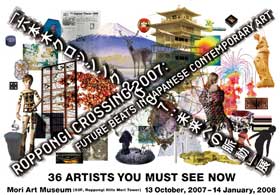 Postings will be slow as i’m currently running from one exhibition to the other in Lyon, Brussels, Gent, etc. and visiting my family and friends around. Normal service will resume on December 27. Meanwhile, Vicente Gutierrez visited yet another Tokyo art exhibition and sent us a report from it:
Postings will be slow as i’m currently running from one exhibition to the other in Lyon, Brussels, Gent, etc. and visiting my family and friends around. Normal service will resume on December 27. Meanwhile, Vicente Gutierrez visited yet another Tokyo art exhibition and sent us a report from it:
A follow up to the 2004 version, the 36 artists featured in Roppongi Crossing were selected by a team of four curators to introduce new emergent talent from Japan while juxtaposing such work alongside influential Japanese artists from the formative decades of the 1960s and 1970s. With both group’s work spanning the spectrum of painting, sculpture, design, video, photography, manga as well as a side of traditional craftwork [with the deliberate exception of architecture and fashion], this exhibit is meant to take the pulse of the Japanese contemporary art scene.
That this team of curators brought them together for this exhibit raises a question- What unites these artists? Is there a kind of Japanese-ness that acts as a gravity? Roppongi Crossing is another high-profile exhibit grouping Japanese artists in recent months which leads me to believe it is curators who have been more focused on asserting a unifying sense of Japanese-ness in the contemporary scene rather than the artists themselves. Meanwhile, younger artists have found themselves confronted with a choice to perceive this Japanese-ness as a unifying theme or as a departure point for themselves.
Some selections on exhibit until January 14, 2008:
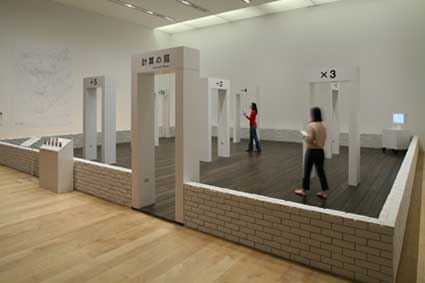 Sato Masahiko + Kiriyama Takashi, Arithmetik Garden 2007. Photo: Kioku Keizo
Sato Masahiko + Kiriyama Takashi, Arithmetik Garden 2007. Photo: Kioku Keizo
Sato Masahiko and Kiriyama Takashi employed RFID technology into an interactive installation whereby participants select a card with a number on it to hang around their neck, essentially becoming a number themselves. Each card is embedded with an RFID chip and participants must pass through the various gates in the mathematical garden with the goal of attaining the total of 73 via various math operations before [successfully] exiting. The computer in the corner tracks user’s steps as well as their current “number.�
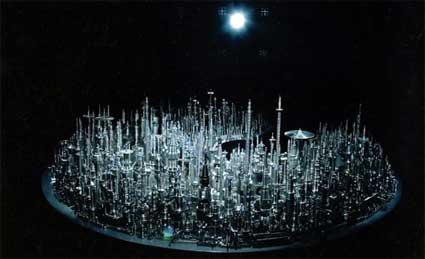 Enoki Chu, RPM-1200, 2005. Hirakakiuchi Yuto courtesy of Mori Art Museum.
Enoki Chu, RPM-1200, 2005. Hirakakiuchi Yuto courtesy of Mori Art Museum.
Viewable from within the center or from a recessed observation deck, RPM-1200 [2005] by Enoki Chu is a futuristic cityscape characterized by highly detailed craftwork with [scrap] metal. Popular since the 1960s, the veteran metalsmith crosses his highly detailed craftsmanship with a scaled-down design installation of an urban landscape right out of a science fiction film.
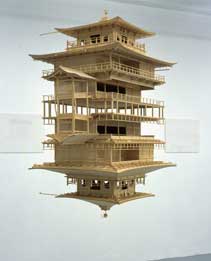
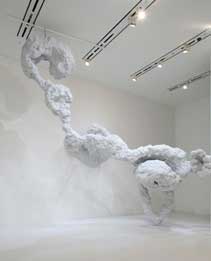 Iwasaki Takahiro, Reflection Model, 2001. Photo: Tomoeda Nozomi and Nawa Kohei, Scum-Compulsion, 2007. Photo: Kioku Keizo
Iwasaki Takahiro, Reflection Model, 2001. Photo: Tomoeda Nozomi and Nawa Kohei, Scum-Compulsion, 2007. Photo: Kioku Keizo
The traditional side of the exhibit emerges from this meticulously constructed scaled-down replica of the much-revered Kinkakuji temple [and it’s reflection, slightly offset for refraction] in Kyoto by Iwasaki Takahiro. Iwasaki’s exercise of restraint and good taste at the same time allows us to see a side of Japan’s orderliness and cleanliness in presentation. Meanwhile, Nawa Kohei’s amorphous sculptures command whatever room they are in, an embodiment of chaos in sculpture. While what is abstract makes deciphering more difficult, Nawa Kohei’s sprawl of white styrofoam is set alongside Kito Kengo’s colorful, spinning hypnosis-inducing polyhedron.
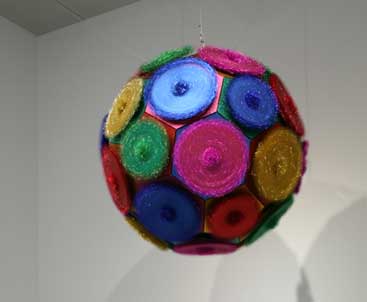 Image on the right: Kito Kengo, Royal, 2007. Photo: Kioku Keizo
Image on the right: Kito Kengo, Royal, 2007. Photo: Kioku Keizo
Entitled Royal, Kito’s colorful and vibrantly visual polyhedron is equipped with small propeller blades and although quietly humming, draws more attention from our eyes than our ears. That their works were intentionally juxtaposed radically reminds us of the varied directions within the younger camp of emergent artists.
Yamaguchi Takashi’s algorithm-based interactive models place us in a new environment where we question the effects of our behavior and perceptions of [virtual] data. Centered around a generative-code program, the featured physical-interaction-digital-realization, interactive model pits two drummers against each other in a virtual space where a grounded colorful grid modulates while each drummer plays.
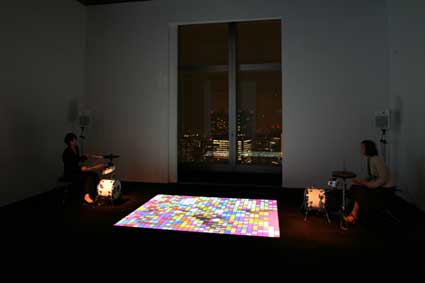 Yamaguchi Takashi, d.v.d.
Yamaguchi Takashi, d.v.d.
Roppongi Crossing exhibit does say a lot about what these four Japanese curators will label as Japanese ‘art’ and as a survey show, the grouping of the 36 artists seemed to result in more fractions than a complete image. Perhaps a more apt title for the exhibit would be questioning what is ‘Japanese-ness’ is Japanese contemporary art- Where do young artists think they are coming from and going which may paint a clearer picture of the Japanese contemporary art scene, although, before we know it, will be time for the next Roppongi Crossing.
All images Courtesy of Mori Art Museum
“Roppongi Crossing 2007 — Future Beats in Japanese Contemporary Art”
Until Jan. 14 2008 at the Mori Art Museum in Roppongi Hills, Tokyo.
